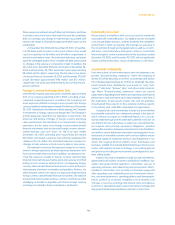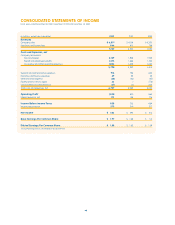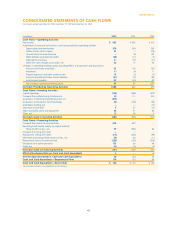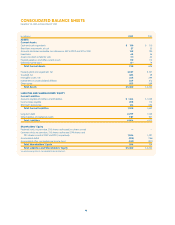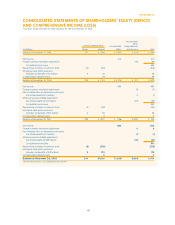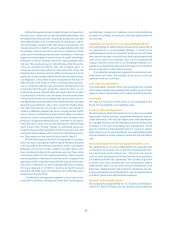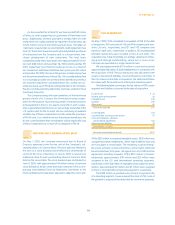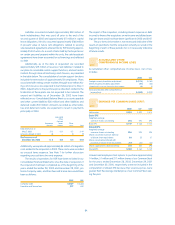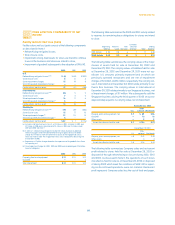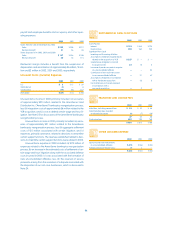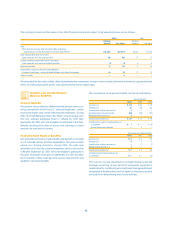Pizza Hut 2002 Annual Report Download - page 54
Download and view the complete annual report
Please find page 54 of the 2002 Pizza Hut annual report below. You can navigate through the pages in the report by either clicking on the pages listed below, or by using the keyword search tool below to find specific information within the annual report.
well as the offsetting gain or loss on the hedged item attributa-
ble to the hedged risk are recognized in the results of operations.
For derivative instruments that are designated and qualify as a
cash flow hedge, the effective portion of the gain or loss on the
derivative instrument is reported as a component of other com-
prehensive income (loss) and reclassified into earnings in the
same period or periods during which the hedged transaction
affects earnings. Any ineffective portion of the gain or loss on the
derivative instrument is recorded in the results of operations
immediately. For derivative instruments not designated as hedg-
ing instruments, the gain or loss is recognized in the results of
operations immediately. See Note 16 for a discussion of our use of
derivative instruments, management of credit risk inherent in
derivative instruments and fair value information related to debt
and interest rate swaps.
New Accounting Pronouncements
Not Yet Adopted
In June 2001, the Financial Accounting Standards Board (“FASB”)
issued SFAS No. 143, “Accounting for Asset Retirement Obligations”
(“SFAS 143”). SFAS 143 addresses the financial accounting and
reporting for legal obligations associated with the retirement of
tangible long-lived assets and the associated asset retirement
costs. SFAS 143 is effective for the Company for fiscal year 2003.
We currently do not anticipate that the adoption of SFAS 143 will
have a material impact on our Consolidated Financial Statements.
In June 2002, the FASB issued SFAS No. 146, “Accounting for
Costs Associated with Exit or Disposal Activities” (“SFAS 146”). SFAS
146 addresses significant issues regarding the recognition, meas-
urement, and reporting of costs associated with exit or disposal
activities, and nullifies Emerging Issues Task Force Issue No. 94-3,
“Liability Recognition for Certain Employee Termination Benefits and
Other Costs to Exit an Activity (including Certain Costs Incurred in
a Restructuring).” Costs addressed by SFAS 146 include costs to ter-
minate a contract that is not a capital lease, costs of involuntary
employee termination benefits pursuant to a one-time benefit
arrangement, costs to consolidate facilities, and costs to relocate
employees. SFAS 146 is effective for exit or disposal activities that
are initiated after December 31, 2002. Although SFAS 146 will
change the timing of expense recognition for certain costs we incur
while closing restaurants or undertaking other exit or disposal
activities, the timing difference is not expected to be significant in
length. We do not anticipate that the adoption of SFAS 146 will have
a material impact on our Consolidated Financial Statements.
In December 2002, the FASB issued SFAS No. 148, “Accounting
for Stock-Based Compensation
—
Transition and Disclosure” (“SFAS
148”). SFAS 148 provides alternative methods of transition for a
voluntary change to the fair value method of accounting for stock-
based employee compensation as required by SFAS 123. In
addition, SFAS 148 amends the disclosure requirements of SFAS 123
to require more prominent and more frequent disclosures in finan-
cial statements about the effects of stock-based compensation.
Our disclosure regarding the effects of stock-based compensa-
tion included in these notes is in compliance with SFAS 148.
In November 2002, the FASB issued Interpretation No. 45,
“Guarantor’s Accounting and Disclosure Requirements for Guar-
antees, Including Indirect Guarantees of Indebtedness to Others,
an interpretation of FASB Statements No. 5, 57 and 107 and a
rescission of FASB Interpretation No. 34” (“FIN 45”). FIN 45
elaborates on the disclosures to be made by a guarantor in its
interim and annual financial statements about its obligations
under guarantees issued. FIN 45 also clarifies that a guarantor is
required to recognize, at inception of a guarantee, a liability for
the fair value of the obligation undertaken. The disclosure require-
ments of FIN 45 are included in Note 24. The initial recognition and
measurement provisions are applicable to guarantees issued or
modified after December 31, 2002. As described in Note 24, we
have in the past provided certain guarantees that would have
required recognition upon issuance or modification under the
provisions of FIN 45. While the nature of our business will likely
result in issuance of certain guarantee liabilities in the future, we
do not anticipate that FIN 45 will have a material impact on the
Consolidated Financial Statements.
In January 2003, the FASB issued Interpretation No. 46,
“Consolidation of Variable Interest Entities, an interpretation of ARB
No. 51” (“FIN 46”). FIN 46 addresses the consolidation of entities
whose equity holders have either (a) not provided sufficient equity
at risk to allow the entity to finance its own activities or (b) do not
possess certain characteristics of a controlling financial interest. FIN
46 requires the consolidation of these entities, known as variable
interest entities (“VIEs”), by a primary beneficiary of the entity. A pri-
mary beneficiary is the entity, if any, that is subject to a majority of
the risk of loss from the VIEs activities, entitled to receive a major-
ity of the VIEs residual returns, or both. FIN 46 applies immediately
to variable interests in VIEs created or obtained after January 31,
2003. For variable interests in a VIE created before February 1,
2003, FIN 46 is applied to the VIE no later than the end of the first
interim or annual reporting period beginning after June 15, 2003
(the quarter ending September 6, 2003 for the Company). The
Interpretation requires certain disclosures in financial statements
issued after January 31, 2003, if it is reasonably possible that the
Company will consolidate or disclose information about variable
interest entities when the Interpretation becomes effective.
52.



